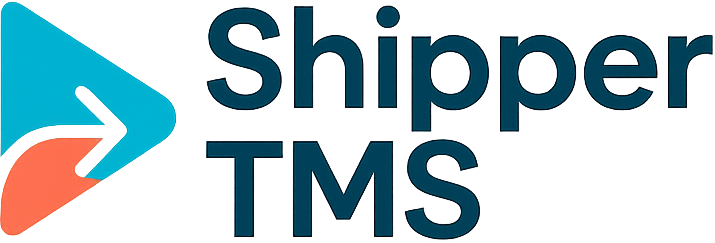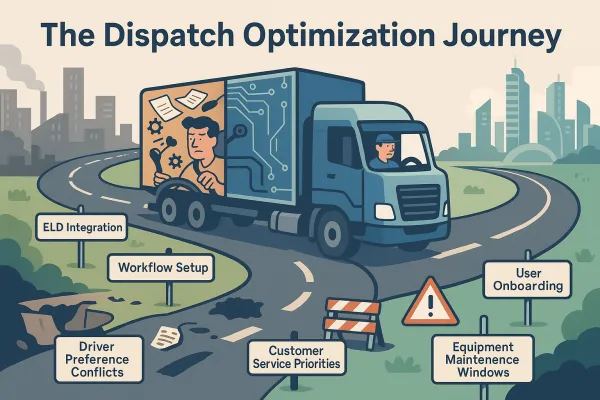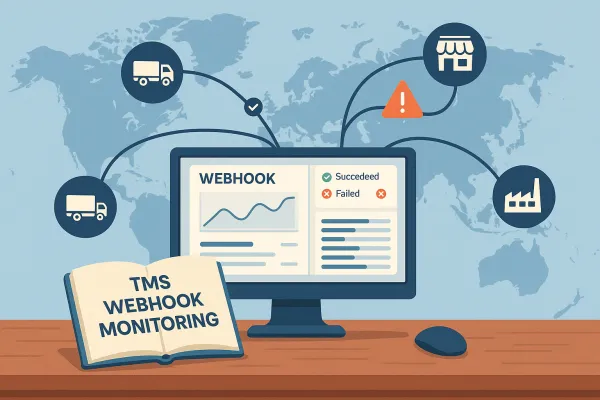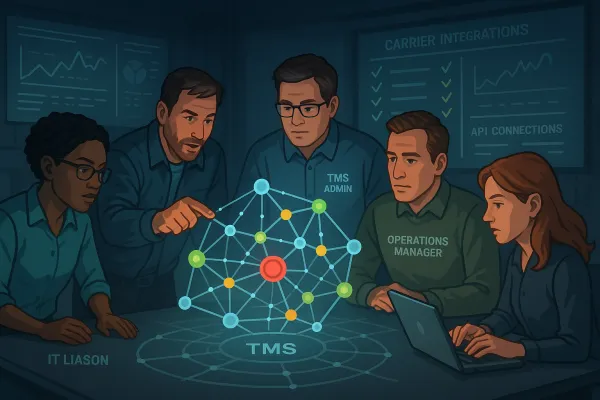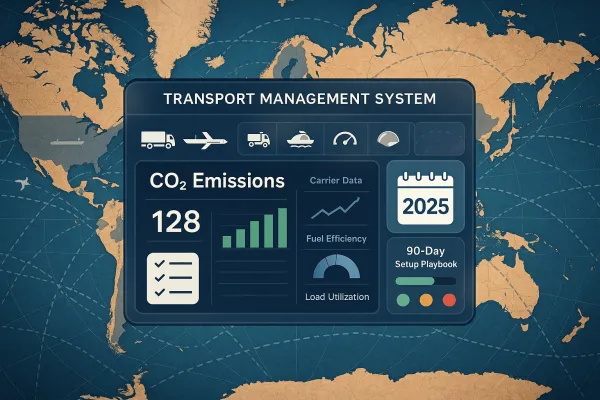TMS User Resistance: The 90-Day Adoption Strategy That Cuts Training Time in Half
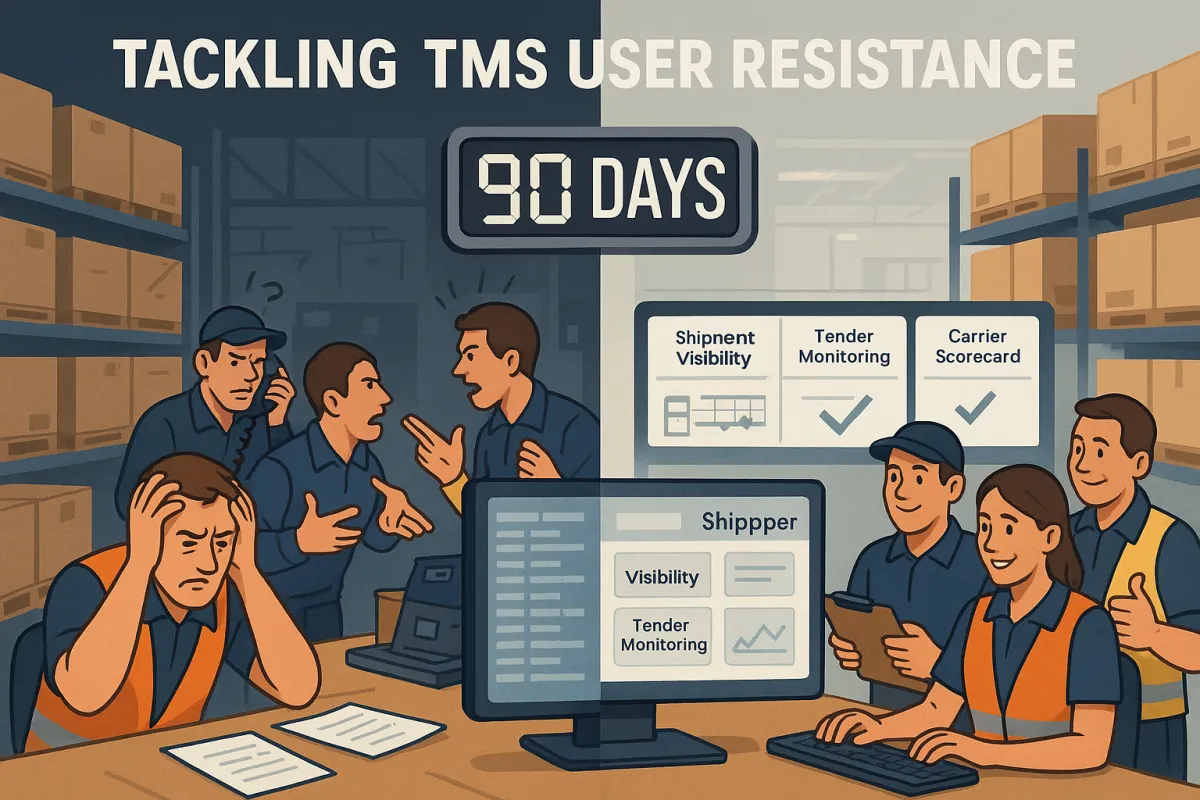
Half of your shipper TMS users resist the new system within 90 days of go-live. You've invested months in selection, configuration, and training, yet dashboards sit empty and workarounds multiply.
Sound familiar? Recent analysis shows that more than 70% of organizations encounter roadblocks during TMS deployment, with user resistance being the primary culprit. Poor onboarding could cost up to 213% of the employee's salary, turning your technology investment into an expensive lesson in change management.
This isn't about buying better software. According to change management statistics, employee resistance to change remains a major challenge, with 37% resisting organizational change management. The top reasons include a lack of trust in leadership (41%), lack of awareness about why change is happening (39%), fear of the unknown (38%), insufficient information (28%), and changes to job roles (27%).
The Hidden Cost of TMS User Resistance
Your resistance problem costs more than you think. When users cling to spreadsheets and manual processes, you lose the benefits you paid for. TMS implementation usually takes 1-2 months for smaller shippers and 3-6 months for a larger, more complex network, but adoption timelines stretch far beyond go-live dates.
Here's what resistance looks like in practice: dispatchers still call carriers instead of using automated tendering, analysts export data to recreate reports in Excel, and managers bypass approval workflows because "the old way was faster." However, successful digital transformation is challenging, as evidenced by the fact that only 16% of organizations report success in their digital transformation efforts, often hindered by poor digital adoption rates.
The numbers tell a brutal story. Another major hurdle involves change management, with around 45% of employees resistant to new systems. When Cargoson, MercuryGate, or Descartes systems go underutilized, you're not just wasting software licenses. You're hemorrhaging operational efficiency gains, losing visibility into carrier performance, and missing cost reduction opportunities that justified the original business case.
Consider this: if your TMS could reduce freight costs by 8% but only 60% of users adopt core features, you're capturing maybe 5% savings. The difference funds competitor advantages while you struggle with manual workarounds.
Why Standard TMS Training Programs Fail
One of the biggest problems with digital adoption is that software training is often insufficient. People using platforms like Dynamics or SharePoint cannot possibly be expected to learn to use these platforms comprehensively with just a day or two of training sessions.
Most TMS vendors deliver generic training that covers every feature but addresses no specific workflow. Your dispatchers get the same overview as your analysts, even though they need completely different capabilities. User training: Approximately 40% of failures stem from inadequate user training. Bespoke platforms enhance usability through intuitive interfaces and personalized training sessions.
Traditional training approaches create three critical gaps. First, timing problems: users receive training weeks before go-live, then forget key steps when they need them. Second, context mismatches: generic examples don't reflect your carrier relationships, routing requirements, or approval hierarchies. Third, skill level assumptions: power users get bored while beginners feel overwhelmed.
The Role Confusion Problem
Different users need fundamentally different training approaches. Your transportation analysts need deep dives into reporting and analytics, while dispatchers need quick access to load tendering and tracking. Managers need dashboard configuration and exception handling, but warehouse coordinators need appointment scheduling and delivery coordination.
When everyone gets identical training, nobody gets what they need. Operations Planners (day-to-day tenderers): Focus on advanced features in the "Tender Monitoring" and "Carrier Scorecard" modules. Show how to reduce double-tendering by 30 percent. Customer Service Teams: Emphasize "Shipment Visibility" and "Accessorial Exception Management." Teach reps to proactively notify customers when a load deviates by > 4 hours.
The result? Users learn features they'll never use while missing capabilities that could transform their daily work. Role-specific training isn't just more effective; it's the difference between adoption and abandonment.
The 90-Day Structured Adoption Framework
Successful TMS adoption follows a structured path, not a single training event. The software adoption process follows six phases: awareness, interest, evaluation, trial, activation, and adoption. Your 90-day framework maps these phases to specific milestones and measurable outcomes.
This approach works because it matches how people actually learn new systems. Instead of overwhelming users with everything upfront, you build confidence through progressive complexity. Each phase has clear success criteria, specific training objectives, and targeted support resources.
Leading TMS platforms like Cargoson, nShift, and Transporeon structure their implementation programs around similar phased approaches. They've learned that user adoption correlates directly with structured learning paths, not feature demonstrations.
Days 1-30: Foundation Phase
Week one focuses on navigation and basic system concepts. Users learn to log in, understand the dashboard layout, and complete one core workflow successfully. Nothing advanced, nothing optional. The goal is confidence, not competence.
Week two introduces role-specific fundamentals. Dispatchers learn load creation and basic tendering. Analysts discover reporting interfaces. Managers explore approval queues. Each group gets homework: complete five transactions using only the TMS.
Weeks three and four expand core workflows while introducing data quality concepts. Users learn why accurate commodity codes matter, how to enter proper pickup/delivery windows, and what information carriers need for acceptance. To drive adoption and quicker benefit realization, training must be clear, role-specific and focused on building user confidence from day one.
Success metrics for foundation phase: 90% login rate, 80% completion rate for assigned workflows, less than 5% error rate on core transactions.
Days 31-60: Workflow Integration Phase
Month two connects TMS capabilities to existing business processes. Instead of learning isolated features, users discover how the system supports their current responsibilities. This phase addresses the "why should I change" question with concrete productivity improvements.
Integration training shows users how TMS data feeds into existing reports, how automated alerts replace manual check calls, and how exception handling reduces firefighting. You're not teaching new processes; you're showing how technology improves familiar ones.
Advanced configuration happens here too. Users customize dashboards, set up personal alerts, and configure approval rules that match their authority levels. When employees are equipped with the necessary skills and knowledge, they are more likely to embrace the new system and utilize its features to their full potential, maximizing the return on investment. Well-trained staff can leverage the TMS to streamline transportation processes, including route planning, carrier selection, and freight management.
Success metrics: 75% reduction in manual workarounds, 50% improvement in data accuracy, 60% of users actively using personalized dashboard views.
Days 61-90: Advanced Operations Phase
The final month focuses on optimization and continuous improvement. Users learn advanced reporting, analytics interpretation, and system administration tasks relevant to their roles. This is where early adopters become power users and internal advocates.
Advanced training covers scenario-based problem solving: handling carrier rejections, managing capacity constraints, and responding to weather delays. Users work through real situations using TMS tools rather than learning theoretical features.
This phase also introduces peer learning opportunities. Strong adopters train struggling colleagues, creating internal expertise networks that reduce dependency on vendor support. Survey power users to find out who is already using underutilized modules. These "Feature Champions" often have informal "tips and tricks" they can share with peers.
Overcoming the Top 5 Resistance Patterns
Every TMS implementation encounters predictable resistance patterns. Studies show that teams with regular feedback opportunities see a 50% reduction in resistance, as employees feel valued and heard. Data reveals that showcasing initial successes can enhance buy-in by as much as 80%. Understanding these patterns allows you to address root causes, not just symptoms.
Resistance rarely stems from technology fears alone. Using data collected from 69 manufacturing organizations through a mail survey, it was found that resistance to change is negatively related to achievement of predetermined goals (b = –0.930, p < 0.01) and usersatisfaction (b = –0.952, p < 0.01). Users resist when change threatens their expertise, job security, or daily comfort. Effective strategies address these underlying concerns while demonstrating clear personal benefits.
The "Old System Was Better" Mindset
This resistance pattern appears when users compare new TMS capabilities to idealized memories of legacy systems. They remember the best parts of old processes while forgetting daily frustrations: hunting for rate sheets, making confirmation calls, and recreating the same reports monthly.
Combat nostalgia with objective comparisons. Document time spent on manual tasks before and after TMS implementation. Show concrete improvements: "Your weekly carrier scorecard used to take four hours to compile. Now it updates automatically every morning." Highlight quick wins and demonstrable results of the new software. Regularly share progress metrics that illustrate efficiency gains or cost savings achieved through the new system.
Create "memory aids" that remind users why change was necessary. Post old pain points in common areas: "Remember waiting 30 minutes on hold with carriers for pickup confirmations?" When users see immediate benefits, resistance fades quickly.
Building Your Change Champions Network
Internal advocates drive adoption better than external trainers. Establish change champions within teams. Organizations leveraging internal advocates report a 30% higher likelihood of adoption, as these individuals effectively communicate the benefits of the new technology. These champions aren't necessarily your most senior people; they're your most influential ones.
Identify champions during the foundation phase. Look for users who ask thoughtful questions, help colleagues, and embrace new workflows quickly. These people become your adoption multipliers, spreading enthusiasm and solving problems organically.
Champions need special support and recognition. Give them early access to advanced features, include them in vendor discussions, and highlight their contributions publicly. When peers see champions succeeding with new technology, adoption accelerates naturally.
Structure champion networks across departments and shifts. Day-shift champions can't help night-shift users directly, so build coverage that matches your operational patterns. To overcome resistance to change, organizations should actively involve employees in the implementation process. Conducting informative workshops, outlining the benefits of the TMS, and highlighting success stories can help create buy-in and enthusiasm among employees.
Measuring Success: KPIs That Actually Matter
Login frequency doesn't equal adoption. Users might access the system daily but still complete critical tasks manually. Effective TMS adoption measurement focuses on workflow completion, data quality, and outcome improvements rather than simple usage statistics.
Track feature utilization by role and function. Are dispatchers using automated tendering or still making phone calls? Do analysts generate reports from TMS data or export everything to Excel? Are managers approving loads through the system or via email? These behavioral indicators reveal true adoption levels.
Monitor data quality improvements as an adoption proxy. When users embrace TMS workflows, data accuracy increases dramatically. Track metrics like complete commodity descriptions, accurate delivery appointments, and proper carrier contact information. Poor data quality signals incomplete adoption.
Measure time-to-proficiency for new users. How long does it take someone to complete their first successful load tender? How many attempts before they generate an accurate carrier scorecard? Organizations that invest in comprehensive training programs report 218% higher revenue and 24% higher profit margins. This impressive return on investment shows just how important employee development is for driving business success. When employees gain new skills and knowledge, it leads to better performance and a more efficient workplace.
Day-2 Operations: Sustaining Adoption Beyond Go-Live
TMS adoption doesn't end when training concludes. TMS optimization is an ongoing initiative. You've invested in the system—make sure to keep investing in its potential. Sustainable adoption requires ongoing support, continuous learning opportunities, and regular process refinements based on user feedback.
Establish monthly user forums where teams share tips, discuss challenges, and request new features. These sessions keep engagement high while identifying optimization opportunities. When users see their suggestions implemented, they become long-term system advocates.
Create advanced training paths for users who master basic workflows. By 2025, 70% of organizations will use digital adoption platforms across the entire technology stack to overcome still insufficient application user experiences. Power users need continuous challenges to maintain interest and develop expertise that benefits the broader organization.
Monitor adoption metrics continuously, not just during implementation periods. User behavior changes over time as business conditions evolve, new employees join, and system capabilities expand. Regular measurement identifies adoption drift before it becomes resistance regression.
Partner with your TMS vendor for ongoing enablement. Whether you use Cargoson, Manhattan Active, or Blue Yonder, vendor support teams understand common adoption challenges and can provide targeted assistance when internal efforts plateau. Facilitate an easy transition with a comprehensive support plan. Ensure that a system is in place to provide round-the-clock assistance to users in case of emergencies or critical issues. Designate a support team to respond to user inquiries, troubleshoot technical issues, and provide guidance on system usage. Establish knowledge sharing practices, such as user forums, FAQs, and documentation repositories to empower users and build self-sufficiency.
Your TMS investment succeeds when users embrace change confidently and competently. The 90-day framework provides structure, but your commitment to ongoing support determines long-term outcomes. Address resistance proactively, celebrate early wins publicly, and measure adoption meaningfully. When you do, technology transforms from an implementation project into a competitive advantage.
